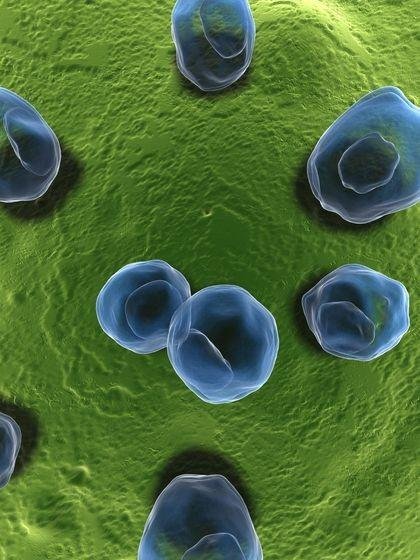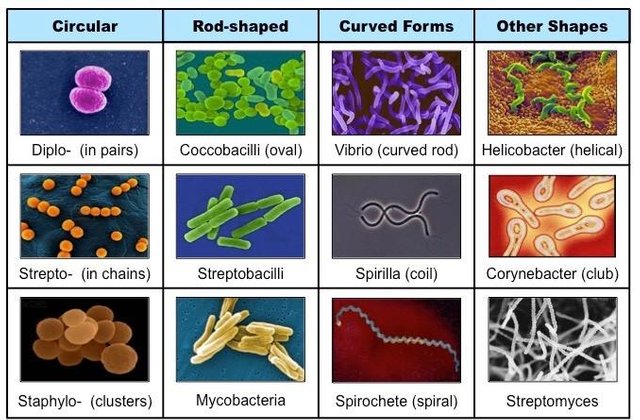Biology Lesson : Eubacteria
Eubacteria
The Eubacteria, also called just "bacteria," are one of the three main domains of life, along with the Archaea and the Eukarya. Eubacteria are prokaryotic, meaning their cells do not have defined, membrane-limited nuclei. As a group they display an impressive range of biochemical diversity, and their numerous members are found in every habitat on Earth. Eubacteria are responsible for many human diseases, but also help maintain health and form vital parts of all of Earth's ecosystems.

Characteristics of Eubacteria
Eubacteria, or microorganisms lacking a defined membrane nucleus, have several general characteristics. All are enclosed by a cellular wall, which is made up of peptidoglycans in a cross-linked chain pattern. This gives the wall of the bacteria the strength needed to maintain its shape and size during changing environments. Small molecules can diffuse through the cell wall, but often a proton gradient must first be established in order for molecule exchange to properly occur. Unlike eukaryotes, bacteria have cholesterol present in the membrane to enhance permeability properties of the membrane and increase stiffness. Similar to eukaryotes, bacteria also have a plasma membrane within the cell wall. Some bacteria may have a flagella, or a projection composed of protein filaments, that is used for movement. Other bacteria may have pili, which are small projections all over the outside of the cell, and are used for sticking to surfaces and transferring DNA. When a large amount of bacteria are attached to a surface and are surrounded by a polysaccharide sac, this is referred to as a biofilm. This complex has high antimicrobial resistance.
Within the plasma membrane of the bacteria is the cytoplasm, or the intracellular milieu. It is composed of mainly water (approximately 80%), but has a gel-like consistency. Bacteria do not have membrane-bound organelles, unlike eukaryotes, which have mitochondria and chloroplasts. There are ribosomes, however, which are organelles that are composed of RNA and used for protein synthesis. Free floating within the cytoplasm is also the genome, or bacterial DNA, found in the nucleoid. Bacterial chromosomes are often circular but can also be linear in shape. This shape comes in handy when a bacterium is undergoing replication. Bacteria can asexually reproduce through binary fission or budding. Binary fission is when two equal progeny cells are produced. Bacteria that undergo binary fission must first elongate before separating. Budding is when there is growth off the parent cell. Binary fission produces two equal daughter cells, while budding produces a new cell while the parent cell remains.
During times of extreme conditions not conducive to replication, such as starvation, eubacteria have the ability to become endospores. In this state, the bacteria can tolerate exceedingly high and low temperatures, acidic and basic conditions, and large amounts of radiation. Endospores are extremely hard to kill. Surprisingly, they can be boiled for hours and still survive. Endospores can only be made by Gram-positive bacteria. Within the endospore remains the bacterial DNA, but the cytoplasm has a decreased water concentration. This is thought to help in protecting against high heat. The bacteria will take on a tough coating composed of calcium and dipicolinic acid, creating a dense and impregnable barrier to stabilize the DNA within the cell. DNA repair enzymes are also still active, aiding in the resistance of the endospore.
Plasmids are also found within bacteria separate from the bacteria’s circular DNA. Also referred to as “replicons”, plasmids are autonomous replicating DNA molecules. Not all plasmids replicate in bacteria, though. These elements allow for horizontal gene transfer, which is a way for a bacterium to gain new genes and therefore traits. They primarily aid in the rapid mutation in bacteria to several factors. Similar to the other genetic material, the plasmids can be passed onto daughter cells during replication. They are the common DNA structure used in research because they are relatively easy to manipulate, implant and measure.
Types of Eubacteria
All bacteria share features common to every prokaryotic cell:
- They lack a nucleus and membrane-bound organelles
- They have circular DNA that is naked (not bound to protein)
- They have smaller ribosomes (70S)
However different types of bacteria can be distinguished according to a number of characteristics:
- Shape – Round (coccus), rod-like (bacillus), comma-shaped (vibrio) or spiral (spirilla / spirochete)
- Cell wall composition – Gram-positive (thick peptidoglycan layer) or Gram-negative (lipopolysaccharide layer)
- Gaseous requirements – Anaerobic (obligate or facultative) or aerobic
- Nutritional patterns – Autotrophic (photosynthetic or chemosynthetic) or heterotrophic
Sub-Classifications of Eubacteria

Life Cycle
Reproduction in bacteria involves duplicating the genetic material and dividing the cell into two daughter cells, a process known as binary fission. Under very favorable conditions, certain bacterial cells can divide as often as once every twenty minutes. Some bacteria, such as Clostridium and Bacillus species, possess the ability to form a resting state, or "spore," when unfavorable conditions are encountered. These spores are very resistant to heat, drying, radiation, and toxic chemicals. Bacterial spores have reportedly been reawakened from a 250-million-year-old salt crystal that existed before the time of the dinosaurs. Sterilization techniques used in medicine must overcome these resistant properties.
Your publications are really beautiful @mulwisdom I've checked most of them and found them amazing you're really worth it all thanks for sharing I hope to be like you in the future I work with all my efforts and perfection of God
Thank very much @waliladeluxe...
Thanks very much
Congratulations @mulwisdom! You have completed some achievement on Steemit and have been rewarded with new badge(s) :
Click on any badge to view your own Board of Honor on SteemitBoard.
For more information about SteemitBoard, click here
If you no longer want to receive notifications, reply to this comment with the word
STOP